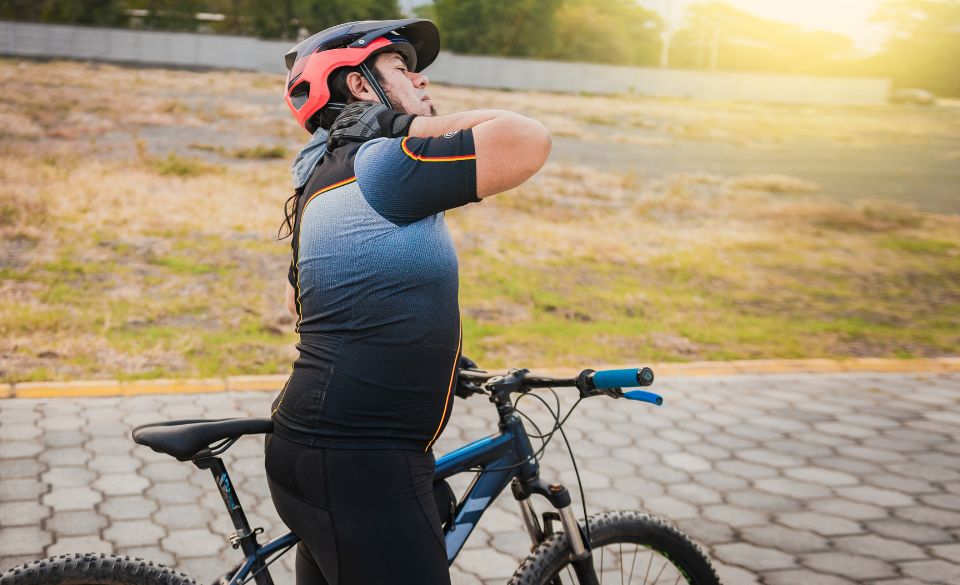
10 Effective Exercises to Alleviate Cycling Neck Pain
Page Contents
- 1. Neck Stretches: Loosen Up and Limber
- 2. Shoulder Blade Squeezes: Strengthen Your Upper Back
- 3. Chin Tucks: Correct Forward Head Posture
- 4. Cat-Cow Stretch: Mobilize Your Spine
- 5. Levator Scapulae Stretch: Target the Troublemaker
- 6. Shoulder Rolls: Loosen Up Your Upper Body
- 7. Resisted Neck Isometrics: Strengthen Your Neck Muscles
- 8. Thoracic Extension: Improve Upper Spine Mobility
- 9. Scalene Muscle Stretch: Release Neck Tension
- 10. Plank Variations: Strengthen Core and Neck Support
- Conclusion: Pedal Pain-Free
Cycling is an incredible way to stay fit and enjoy the great outdoors, but it’s not without its downsides. One common issue cyclists face is neck pain, which can be a real pain in the…well, neck! Whether you’re a casual rider or a seasoned cyclist, neck discomfort can put a damper on your two-wheeled adventures. But fear not, we’ve got your back (or rather, your neck) covered! In this blog post, we’ll explore 10 effective exercises that can help alleviate cycling-related neck pain and keep you pedaling happily.
1. Neck Stretches: Loosen Up and Limber
Start with some simple neck stretches to release tension and increase flexibility. Gently tilt your head to the left, bringing your ear toward your shoulder. Hold for 15-30 seconds, feeling the stretch along the right side of your neck. Repeat on the other side. To target the back of your neck, tilt your head forward, bringing your chin toward your chest. Hold for another 15-30 seconds. These stretches can help improve your neck’s range of motion and relieve stiffness.
A study published in the “Journal of Orthopaedic & Sports Physical Therapy” emphasized the importance of regular neck stretches in preventing and managing neck pain, especially in individuals with desk-bound jobs, which can also contribute to neck discomfort.
2. Shoulder Blade Squeezes: Strengthen Your Upper Back
Weak upper back muscles can contribute to neck pain, especially when you’re hunched over your handlebars. Sit or stand with your shoulders relaxed. Squeeze your shoulder blades together as if you’re trying to hold a pencil between them. Hold for a few seconds, then release. Repeat this exercise for 10-15 repetitions. Strengthening your upper back can help you maintain better posture while cycling and reduce strain on your neck.
Research from the “Journal of Physical Therapy Science” highlights the importance of strengthening the upper back muscles to reduce neck pain and improve posture, particularly in individuals with a sedentary lifestyle.
3. Chin Tucks: Correct Forward Head Posture
Forward head posture, where your head juts forward from your shoulders, is a common issue among cyclists. Chin tucks can help correct this problem. Sit or stand with your shoulders relaxed. Gently tuck your chin in towards your chest, keeping your head level. Hold for a few seconds, then release. Repeat for 10-15 repetitions. This exercise can retrain your neck and upper back muscles to maintain a more neutral posture.
A study in the “European Journal of Physical and Rehabilitation Medicine” recommends chin tucks as an effective exercise to improve forward head posture and alleviate neck pain.
4. Cat-Cow Stretch: Mobilize Your Spine
The cat-cow stretch is a yoga-inspired exercise that can help mobilize your spine and alleviate neck discomfort. Start on your hands and knees in a tabletop position. Inhale as you arch your back, lifting your head and tailbone toward the ceiling (cow pose). Exhale as you round your back, tucking your chin toward your chest (cat pose). Repeat this motion for 10-15 cycles. The cat-cow stretch can improve the flexibility of your entire spine, which can relieve tension in your neck.
Studies published in the “Journal of Bodywork and Movement Therapies” have shown that yoga-based exercises like the cat-cow stretch can effectively reduce neck pain and improve overall spinal mobility.
5. Levator Scapulae Stretch: Target the Troublemaker
The levator scapulae muscle, which connects your shoulder blade to your neck, often becomes tense during cycling. Stretching it can provide relief. Sit or stand up straight. Gently tilt your head to one side, bringing your ear toward your shoulder. Simultaneously, rotate your head slightly forward and downward. Hold this position for 15-30 seconds, feeling the stretch along the side of your neck. Repeat on the other side. This exercise specifically targets the levator scapulae, providing relief from its tension.
According to a study in the “Journal of Physical Therapy Science,” targeted stretching of the levator scapulae muscle can significantly reduce neck pain in individuals with muscle-related neck discomfort.
6. Shoulder Rolls: Loosen Up Your Upper Body
Shoulder rolls are a quick and easy exercise to release tension in your neck and upper back. Sit or stand with your shoulders relaxed. Roll your shoulders forward in a circular motion for 10-15 repetitions, then reverse the direction. This exercise can help improve blood circulation in the neck and upper back area, reducing muscle tightness and discomfort.
Research published in the “Journal of Manipulative and Physiological Therapeutics” suggests that simple exercises like shoulder rolls can effectively relieve neck pain and improve range of motion.
7. Resisted Neck Isometrics: Strengthen Your Neck Muscles
Strengthening your neck muscles can provide stability and support to reduce cycling-related neck pain. Place your hand on your forehead and gently press your forehead into your hand, creating resistance. Hold for 5-10 seconds, then relax. Repeat the same motion with your hand on the back of your head, your left temple, and your right temple. These resisted neck isometrics can help build strength and endurance in your neck muscles.
A study in the “Journal of Back and Musculoskeletal Rehabilitation” highlights the effectiveness of resisted neck isometric exercises in reducing neck pain and improving muscle strength in individuals with chronic neck pain.
8. Thoracic Extension: Improve Upper Spine Mobility
Limited upper spine mobility can lead to compensatory movements in the neck, resulting in pain. The thoracic extension exercise can help improve mobility in your upper spine. Sit or stand with your hands behind your head, elbows pointing out to the sides. Gently arch your upper back backward, looking upward without straining your neck. Hold for 15-30 seconds, then return to the starting position. This exercise enhances your upper spine’s flexibility, reducing the strain on your neck.
Studies published in the “Journal of Physical Therapy Science” have indicated that thoracic extension exercises can significantly reduce neck pain and improve upper body posture.
9. Scalene Muscle Stretch: Release Neck Tension
The scalene muscles, located on the sides of your neck, can become tight and contribute to neck pain. To stretch them, sit or stand with your shoulders relaxed. Tilt your head to one side, bringing your ear toward your shoulder. With your opposite hand, gently apply downward pressure to your collarbone. Hold for 15-30 seconds, feeling the stretch along the side of your neck. Repeat on the other side. This stretch can effectively target the scalene muscles, providing relief from tension.
Research from the “Journal of Manipulative and Physiological Therapeutics” has shown that stretching the scalene muscles can alleviate neck pain and improve neck mobility.
10. Plank Variations: Strengthen Core and Neck Support
A strong core can help support your upper body while cycling, reducing the strain on your neck. Incorporate plank variations into your routine to strengthen your core and neck support. Start with a standard plank: position your forearms on the ground, elbows beneath your shoulders, and toes on the floor. Keep your body in a straight line from head to heels. Hold for 20-30 seconds, gradually increasing the duration as you get stronger. You can also incorporate side planks and forearm planks to target different core muscles.
According to a study in the “Journal of Sports Medicine and Physical Fitness,” core strengthening exercises like planks can improve posture and reduce the risk of neck pain in cyclists.
Conclusion: Pedal Pain-Free
Cycling neck pain doesn’t have to be a constant companion on your rides. By incorporating these exercises into your routine, you can strengthen, stretch, and mobilize the key muscles involved, leading to a more comfortable and enjoyable cycling experience. Remember, it’s essential to perform these exercises consistently and correctly to maximize their benefits. If your neck pain persists or worsens, consult a healthcare professional for further evaluation and guidance.



